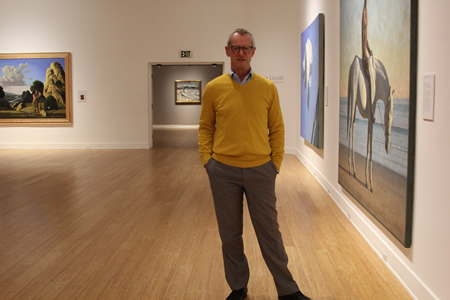In a last minute addition to a wish-list of city expenditures, the Laguna Beach City Council preliminarily agreed Tuesday, Jan. 12, to issue $1 million matching grants to both Laguna Playhouse and the Laguna Art Museum over four years.

By unanimous vote, the council agreed to set aside $500,000 for grants beginning this year to the two institutions, immediately elevating the city of Laguna Beach among the town’s most generous arts patron.
Grant monies will come out of a $4.8 million city budget windfall, amassed due to higher than expected revenue and conservative spending in the year ending June 30, 2015. City Manager John Pietig had recommended that a majority of the windfall be saved to pay for possible El Nino storm damage. In his first days on the job as the city’s top executive in 2010, Pietig pulled on knee-high rain boots to inspect flood damage that cost the city $7.7 million.
Instead, the council approved a smaller $2.8 million storm reserve. Aside from the arts grants, the council also approved other major expenditures that included $500,000 towards defending a lawsuit over its treatment of the homeless and $460,000 in 3.5 percent salary increases for 107 municipal employees and 24 managers.
Council member Bob Whalen initiated the grant proposal for the cultural institutions that are nearing the century mark to “elevate the artistic and creative excellence of each.” He anticipated that the grants would be “extraordinarily impactful” for the two organizations.
In explaining why he initiated the proposal, Whalen said the city should recognize the longevity of two organizations that enrich the community and invest in helping sustain them into their second century. Such an investment buoys the rest of the city’s economy and will inspire greater private giving in the private sector, he said.
Leaders of both arts institutions graphically testified to the consequence of postponed capital improvements.
Playhouse Executive Director Karen Wood described an extra hectic recent opening night premiere. Instead of greeting guests, which included the show’s playwrights visiting from France, she scurried to find buckets for each of the six leaks in her office.
Museum Executive Director Malcolm Warner said the quality of exhibitions has been hurt because of his inability to borrow art. Requests for loans have been rejected by institutions that examine the museum’s temperature log, he said, which reveal a heating and air conditioning system that can’t maintain an even temperature.
The city’s cumulative pledges are the largest ever received by the museum or the Playhouse, officials of the arts groups say. In an interview, Robert Hayden III, the museum’s chairman, predicted raising the matching money will be easy, sparked by the momentum of its major donor. “It gives the sense that the whole community is behind us; it’s a vote of confidence,” Hayden said.
Local artists established the museum in 1918 with artist Edgar Payne its first president. After they first showed their works in a converted board-and-batten cottage, artists in 1929 opened a grand, custom-built gallery due to the success of a fundraising drive led by another early painter, Anna Hills. It survives today as the museum’s main gallery.
Over the Playhouse’s 95-year history, it has evolved from a community theater to a professional one that annually attracts an audience of 80,000. To ride out the recent recession, the Playhouse resorted to renting its house and provided a much-needed venue for dance and music presenters.
Arts supporters Matt Lawson and Betsy Jenkins respectively laid out economic and aesthetic reasons for embracing the proposal.
“These are twin pillars of the arts community,” Lawson said. “They provide a tangible benefit for the entire community,” he said, citing an economic survey estimating that the town’s cultural programs cumulatively generate $50 million in annual spending. “We need this to maintain the vitality of the local economy,” he said.
Jenkins cited Warner’s discerning programming, mounting critically praised exhibits paired with smaller-scale ones showcasing local art treasures. “This is our museum once again,” she said.
“Supporting these investments is a wise investment,” added local filmmaker GregMacGillivray. “We have to keep the arts culture alive here,” he said.
Council member Toni Iseman signaled her intention to support the measure. “It’s our heritage; we haven’t been in a position to do this before,” she said.
Council members said they intended to fine-tune the proposal at a future session. As written, the grants could be applied for a wide range of uses, including repairs, websites and even art purchases.
That didn’t sit well with Council member Rob Zur Schmiede. He questioned the grant’s scope, urging it underwrite physical improvements alone. “I don’t think city money should be used to acquire art, programming or personnel,” he said. “In order to be sustainable, they need to be one-time costs, such as deferred maintenance.”
Council member Kelly Boyd raised another caution flag and referenced a dark era of museum history, the aborted 1996 merger with the Newport Art Museum. “Art came out of the museum that never came back,” Boyd said of the takeover. “If we do this, we have to be careful,” he said, as the museum located at 307 Cliff Dr. is not a public building, unlike the Playhouse property.
Ultimately, the council decided to revisit the issue and better define the grant terms. “I think we want to resist the temptation to tie their hands,” Whalen said.





[…] homeless population is to bring yet another lawsuit against us? This in turn has caused our city to set aside $500,000 to mount a legal defense against ACLU’s […]
[…] grants were preliminarily approved in January when the council’s mid-year budget update revealed a $4.8 million surplus from […]